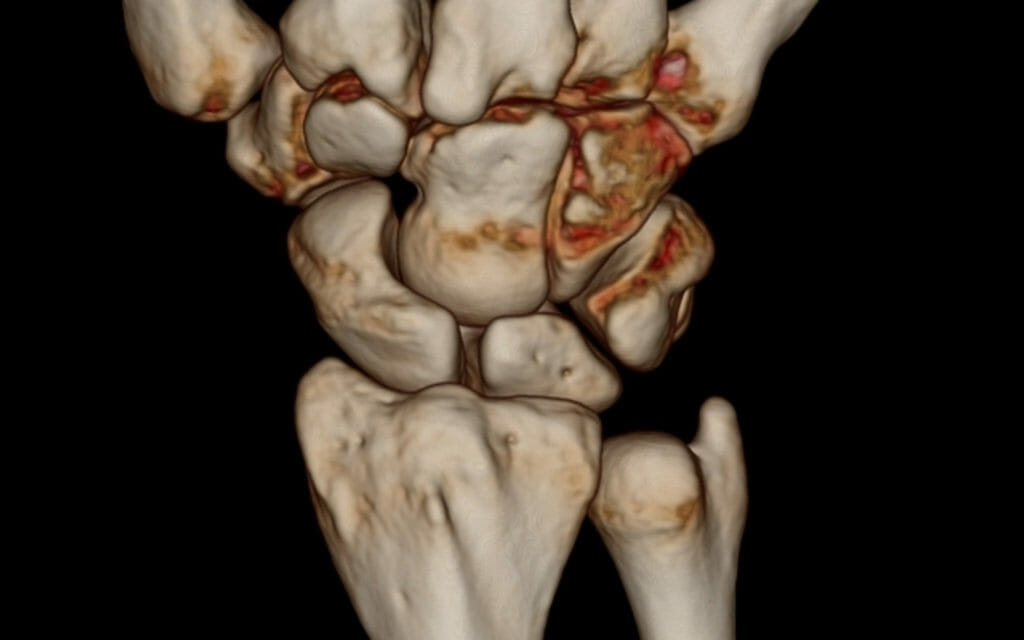The goal is to produce a single unified source of names and codes for radiology procedures with a cooperative governance process. We published the first version of the new LOINC/RSNA Radiology Playbook in December 2015. The first domain of content we put through the unification gauntlet was computed tomography (CT) procedures.
When mapping local radiology exam codes to LOINC, it can be difficult to figure out what to do with exam names containing 3D or reconstruction. Here’s a brief guide to help you sort it out.

Case courtesy of Dr Andrew Dixon, Radiopaedia.org. From the case rID: 45342
3D Post processing terms
The LOINC Users’ Guide describes our approach with 3D fairly well:
Also note that “3D post processing” is included here as a value of the Reason for exam attribute. This refers to image rendering done after image acquisition. Some facilities bill for such renderings, which may be used for surgical planning or other purposes. As a result, these renderings (at least sometimes) constitute an end-product of the exam, and we have thereby chosen to model such processing as a reason for performing the exam. While 3D post processing may also be used simply as a diagnostic tool in image interpretation (and thus not technically a reason for performing the study), we have elected to simply model any description of 3D post processing here.
and
3D is an image processing step, and can be performed on images from a variety of modalities. Its use is discouraged. If adopted locally, it may be used as shown in the Chapter on Reason for Exam.
But, we don’t make it clear enough that the codes in the LOINC/RSNA Playbook are for the 3D post processing portion only.
The names in LOINC and RadLex Playbook omit a preposition (i.e. by). For example:
[79096-4] Chest CT 3D post processing WO contrast
So, the name is a clue, but could make it more obvious. In the upcoming version of LOINC we will clarify that in the User’s Guide and the term descriptions.
Overall though, use of these codes is not encouraged.
When they are used, these codes are typically “add-ons” to the primary exam code. The origin of this style comes from institutions that create their procedure codes mimicking the CPT code billing model. CPT has historically had separate codes for this post-processing (and even different codes for whether or not it had to be done on a separate computer workstation) because of its orientation towards clinical workload.
The LOINC/RSNA Playbook team doesn’t think that’s a great model to follow for procedure names, but has the codes because it is relatively common.
By Reconstruction
The current version of the LOINC Users’ Guide is suspiciously silent about the “by reconstruction” terms. This was just an oversight on our part that will be corrected in the next version. These terms are meant to cover reconstruction (and reinterpretation) of previously acquired raw image data. Such reconstruction generates a “new study” (not new imaging, but a new reading and new report).
In contrast to the post-processing terms, use of “by reconstruction” terms is perfectly acceptable.
Here’s an example scenario where “by reconstruction” codes could be used:
A multiple trauma patient is seen in the emergency department. The patient is intubated and not doing well. The EM physician orders CT studies of the chest, abdomen, and pelvis. The CT studies are performed, and the professional and technical components for these procedures reported. The patient is then admitted to the hospital. Four hours later, the trauma service orders CT studies of the thoracic and lumbar spine reconstructed per the standard protocol (axial, coronal, and sagittal reconstruction) from the prior CT of the abdomen and pelvis.
Our plan is to add a section to the LOINC Users’ Guide about reconstruction, and also add a short description to these terms in LOINC.
The terms “reconstruction” and “reformatting” are occasionally used synonymously, but refer to different processes. This summary explanation by helps clear things up:
Image reconstruction is the term describing the calculation of images from the raw data obtained from the detector modules of the CT scanner. This is a process that cannot be performed in real time. The reconstruction of image data with a soft tissue or bone algorithm can only be performed from the raw data. Once the raw data is lost or deleted image reconstructions are no longer possible. Reformatting or other three-dimensional (3D) image manipulation of the image data is still possible.
Often the first reconstruction is performed in relatively thick slices to ensure a quick workflow. If no obvious problem is identified, the patient can be taken out of the scanner while thinner reconstructions are calculated. While theoretically any imaging plane can be chosen as reconstruction plane, usually reconstructions are performed in the axial plane. In orthopaedic imaging reconstructions should routinely be performed with soft tissue and bone kernels…
Acknowledgments
This material contains content from LOINC® (http://loinc.org). The LOINC table, LOINC codes, and LOINC panels and forms file are copyright © 1995-2017, Regenstrief Institute, Inc. and the Logical Observation Identifiers Names and Codes (LOINC) Committee and available at no cost under the license at http://loinc.org/terms-of-use.

